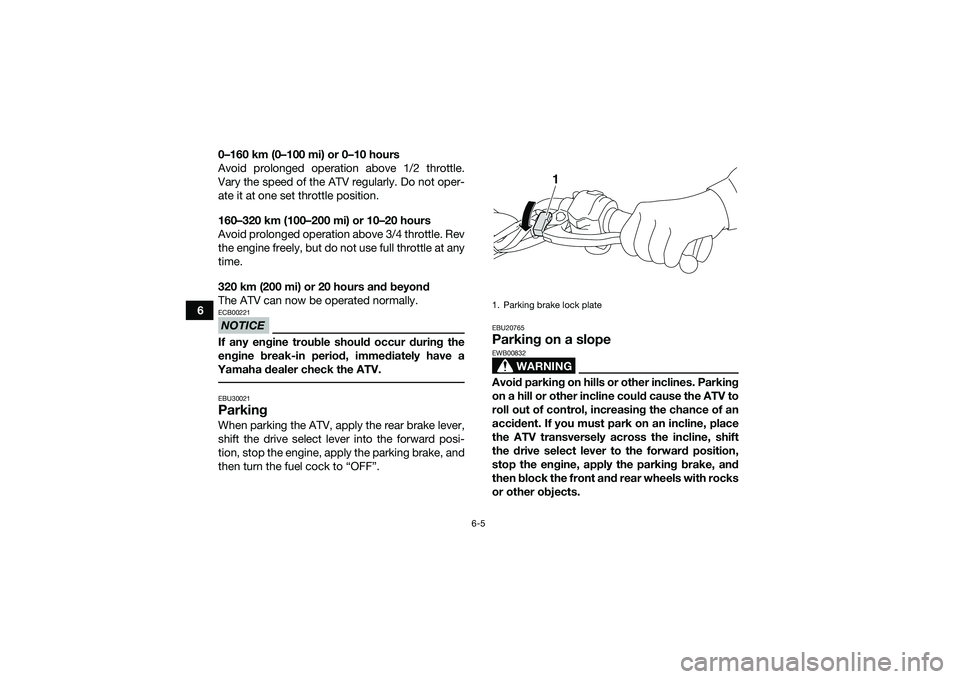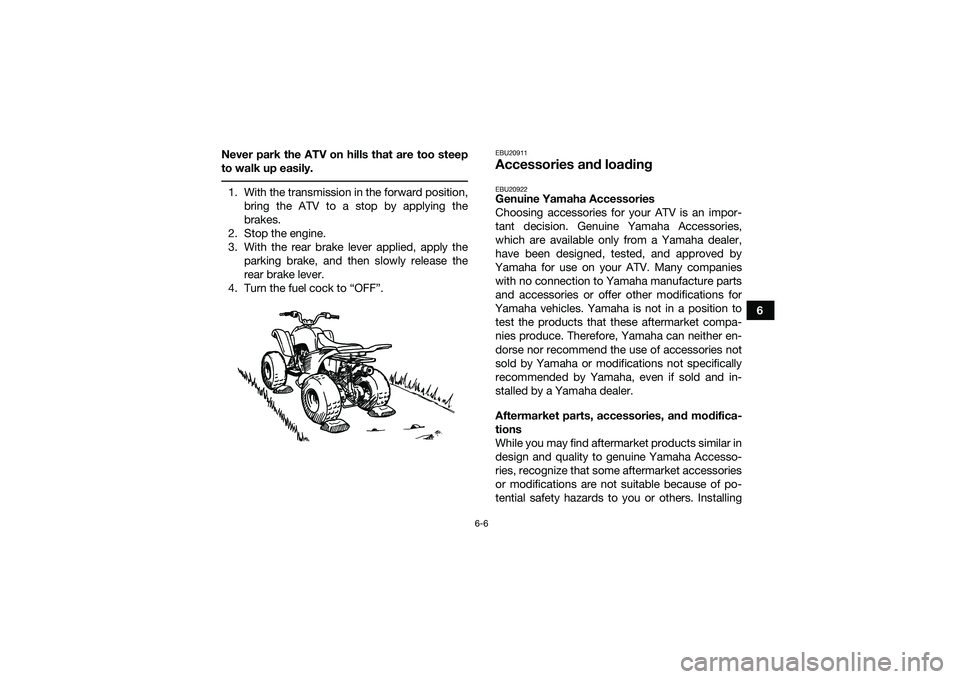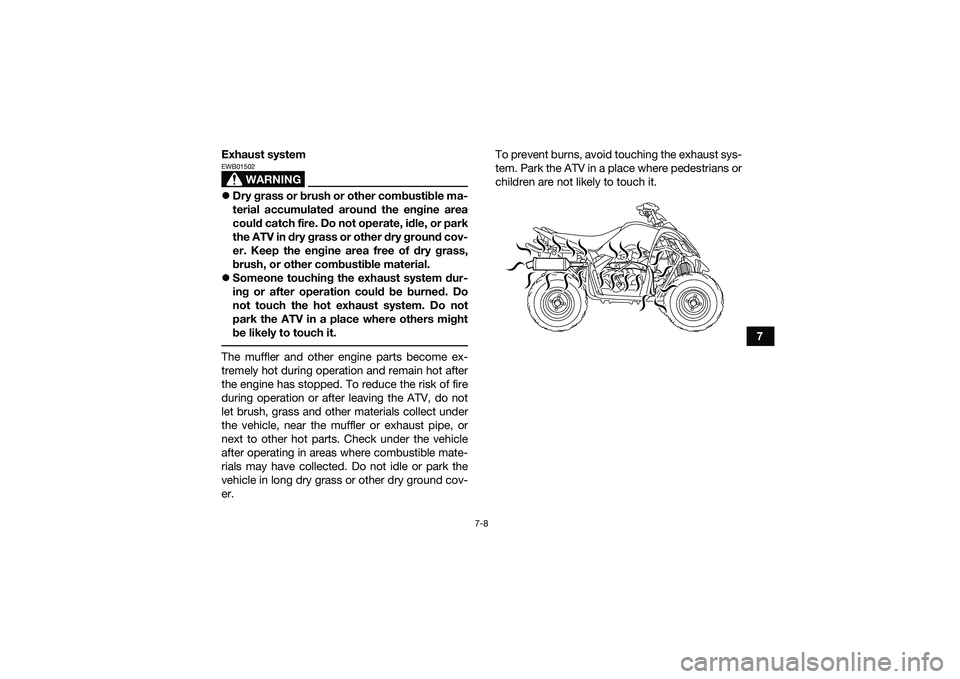Page 52 of 128

6-3
6
EBU20292Starting a warm engineFollow the same procedure as for starting a cold
engine, with the exception that the starter (choke)
is not required when the engine is warm. Instead,
start the engine with the throttle slightly open.EBU33830Operating the drive select lever and
driving in reverseNOTICEECB00171Before shifting, stop the ATV, otherwise the
transmission may be damaged. Shifting: Forward1. Bring the ATV to a complete stop.
2. Apply the rear brake lever.
3. Shift from neutral to forward and vice versa by moving the drive select lever along the
shift guide.TIPMake sure that the drive select lever is completely
shifted into position.
4. Open the throttle lever gradually.
Shifting: Reverse
WARNING
EWB00721Improper operation in reverse could make you
hit an obstacle or even a person behind you,
resulting in serious injury. When you shift into
reverse, make sure there are no people or ob-
stacles behind you. When it is safe to proceed,
go slowly. 1. Drive select lever
2. F (Forward)
3. N (Neutral)
4. R (Reverse)
FNR
234
1
UBD360E0.book Page 3 Wednesd ay, February 25, 2015 2:41 PM
Page 53 of 128

6-4
6
1. Bring the ATV to a complete stop.
2. Apply the rear brake lever.
3. Shift from neutral to reverse and vice versa by
moving the drive select lever along the shift
guide.
TIPWhen in reverse, the reverse indicator light should
come on. If the indicator light does not come on,
have a Yamaha dealer check the electrical circuit.
4. Check behind for people or obstacles, andthen release the rear brake lever.
5. Open the throttle lever gradually and continue to watch to the rear while backing.EBU20683Engine break-inTIPFor ATVs equipped with an odometer or an hour
meter, follow the figures given in km (mi) or the
figures given in hours.
For ATVs not equipped with an odometer or
hour meter, follow the figures given in hours. There is never a more important period in the life
of your engine than the first 320 km (200 mi) or 20
hours of riding. For this reason, you should read
the following material carefully.
Since the engine is brand new, do not put an ex-
cessive load on it for the first 320 km (200 mi) or
20 hours. The various parts in the engine wear and
polish themselves to the correct operating clear-
ances. During this period, prolonged full-throttle
operation or any condition that might result in en-
gine overheating must be avoided.
1. Drive select lever
2. F (Forward)
3. N (Neutral)
4. R (Reverse)
FNR
234
1
UBD360E0.book Page 4 Wednesd ay, February 25, 2015 2:41 PM
Page 54 of 128

6-5
60–160 km (0–100 mi) or 0–10 hours
Avoid prolonged operation above 1/2 throttle.
Vary the speed of the ATV regularly. Do not oper-
ate it at one set throttle position.
160–320 km (100–200 mi) or 10–20 hours
Avoid prolonged operation above 3/4 throttle. Rev
the engine freely, but do not use full throttle at any
time.
320 km (200 mi) or 20 hours and beyond
The ATV can now be operated normally.
NOTICEECB00221If any engine trouble should occur during the
engine break-in period, immediately have a
Yamaha dealer check the ATV. EBU30021ParkingWhen parking the ATV, apply the rear brake lever,
shift the drive select lever into the forward posi-
tion, stop the engine, apply the parking brake, and
then turn the fuel cock to “OFF”.
EBU20765Parking on a slope
WARNING
EWB00832Avoid parking on hills or other inclines. Parking
on a hill or other incline could cause the ATV to
roll out of control, increasing the chance of an
accident. If you must park on an incline, place
the ATV transversely across the incline, shift
the drive select lever to the forward position,
stop the engine, apply the parking brake, and
then block the front and rear wheels with rocks
or other objects.1. Parking brake lock plate
1
UBD360E0.book Page 5 Wednesd ay, February 25, 2015 2:41 PM
Page 55 of 128

6-6
6
Never park the ATV on hills that are too steep
to walk up easily.
1. With the transmission in the forward position,
bring the ATV to a stop by applying the
brakes.
2. Stop the engine.
3. With the rear brake lever applied, apply the parking brake, and then slowly release the
rear brake lever.
4. Turn the fuel cock to “OFF”.
EBU20911Accessories and loadingEBU20922Genuine Yamaha Accessories
Choosing accessories for your ATV is an impor-
tant decision. Genuine Yamaha Accessories,
which are available only from a Yamaha dealer,
have been designed, tested, and approved by
Yamaha for use on your ATV. Many companies with no connection to Yamaha manufacture parts
and accessories or offer other modifications for
Yamaha vehicles. Yamaha is not in a position to test the products that these aftermarket compa-
nies produce. Therefore, Yamaha can neither en-
dorse nor recommend the use of accessories not
sold by Yamaha or modifications not specifically
recommended by Yamaha, even if sold and in-
stalled by a Yamaha dealer.
Aftermarket parts, accessories, and modifica-
tions
While you may find aftermarket products similar in
design and quality to genuine Yamaha Accesso-
ries, recognize that some aftermarket accessories
or modifications are not suitable because of po-
tential safety hazards to you or others. Installing
UBD360E0.book Page 6 Wednesd ay, February 25, 2015 2:41 PM
Page 60 of 128
7-3
7teristics. Take the time to learn the basic tech-
niques well before attempting more difficult
maneuvers.
Not recommended for children under 10 years
of age.
WARNING
EWB03530A child under 10 should never operate an ATV
with engine size greater than 70 cc. Use by
children of ATVs that are not recommended for
their age can lead to severe injury or death of
the child.
This ATV is designed to carry the operator only
– passengers prohibited.
The long seat is to allow the operator to shift posi-
tion as needed during operation. It is not for carry-
ing passengers.
WARNING! Never carry a
passenger. Carrying a passenger on this ATV
greatly reduces your ability to balance and
control this ATV. You could have an accident,
resulting in severe injury or death to you and/or
your passenger.
[EWB01402]
UNDER
10
UBD360E0.book Page 3 Wednesd ay, February 25, 2015 2:41 PM
Page 62 of 128

7-5
7Pre-operation checks
Always inspect your ATV before use to make sure
that it is safe operating condition. Perform the pre-
operation checks listed on page 5-1. Follow the
maintenance schedules and procedures as de-
scribed in the “Periodic Maintenance and Adjust-
ment“ section of this manual.
WARNING! Failure
to inspect the ATV before riding it or failure to
maintain it properly increases the possibility of
an accident and equipment damage.
[EWB01433]
Speed limiter
For beginning riders, riders less experienced with
this model, or whenever limited speed is desir-
able, the throttle lever housing is equipped with a vehicle speed limiter. The speed limiter keeps the
throttle from fully opening, even when the throttle
lever is pushed to the maximum. Turning in the
adjusting screw limits the maximum engine power
available and decreases the maximum speed of
the ATV. Turning in the adjusting screw decreases
top speed, and turning it out increases top speed.
(See page 4-3.)
This model also has an engine speed limiter plate
to limit the amount of engine power available.
Yamaha recommends that all beginning riders start off with the engine speed limiter plate in-
stalled and the vehicle speed limiter adjusting
screw turned in to limit the amount of speed avail-
able while they learn. The vehicle speed limiter
may be gradually adjusted to increase maximum
speed as the beginner becomes more familiar with
operating the ATV. Parents should decide when to
adjust the ATV for more power as their young-
ster’s riding skills improve. Once the ATV rider can
operate with skill at the top speed permitted by
adjusting the vehicle speed limiter alone, the en-
gine speed limiter plate can be removed. Since re-
moval of this plate will result in a significant
increase in power, turn the vehicle speed limiter
adjusting screw back in again and adjust it out inUBD360E0.book Page 5 Wednesd ay, February 25, 2015 2:41 PM
Page 63 of 128

7-6
7
stages as you did before. For engine speed limiter
plate removal instructions, see page 4-4.
Loading and accessories
WARNING
EWB00973Improper loading or towing can increase the
risk of loss of control, an overturn, or other ac-
cident. To reduce the risk of an accident:
Do not exceed the maximum loading limits
for the vehicle (see “MAXIMUM LOADING
LIMIT” below or vehicle labeling).
Make sure the load does not interfere with
your control or ability to see where you are
going.
Reduce speed and allow more room to stop.
A heavier vehicle takes longer to stop.
Avoid hills and rough terrain. Choose terrain
carefully. Use extreme caution when towing
or carrying a load on inclines.
Turn gradually and go slowly.
As originally equipped, this ATV is not designed to
carry cargo or tow a trailer. If you choose to add
accessories to carry cargo, you must use com-
mon sense and good judgment.
Use extra caution when riding the ATV with addi-
tional loads, such as accessories or cargo. The
ATV’s handling may be adversely affected. Re-
duce your speed when adding additional loads.
During operation
Always keep your feet on the footboards during
operation; otherwise, they may contact the rear
wheels. WARNING! Removing even one hand or
foot can reduce your ability to control the ATV
or could cause you to lose your balance and
1. Adjusting screw
1
MAXIMUM LOADING LIMIT ATV loading limit (total weight of cargo, rid-
er, accessories, and tongue weight):82.0 kg (181 lb)
UBD360E0.book Page 6 Wednesd ay, February 25, 2015 2:41 PM
Page 65 of 128

7-8
7
Exhaust system
WARNING
EWB01502
Dry grass or brush or other combustible ma-
terial accumulated around the engine area
could catch fire. Do not operate, idle, or park
the ATV in dry grass or other dry ground cov-
er. Keep the engine area free of dry grass,
brush, or other combustible material.
Someone touching the exhaust system dur-
ing or after operation could be burned. Do
not touch the hot exhaust system. Do not
park the ATV in a place where others might
be likely to touch it. The muffler and other engine parts become ex-
tremely hot during operation and remain hot after
the engine has stopped. To reduce the risk of fire
during operation or after leaving the ATV, do not
let brush, grass and other materials collect under
the vehicle, near the muffler or exhaust pipe, or
next to other hot parts. Check under the vehicle
after operating in areas where combustible mate-
rials may have collected. Do not idle or park the
vehicle in long dry grass or other dry ground cov-
er. To prevent burns, avoid touching the exhaust sys-
tem. Park the ATV in a place where pedestrians or
children are not likely to touch it.UBD360E0.book Page 8 Wednesd
ay, February 25, 2015 2:41 PM